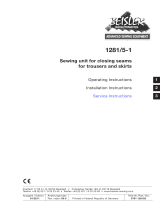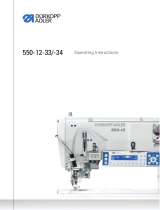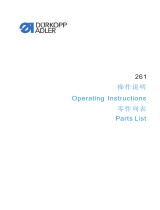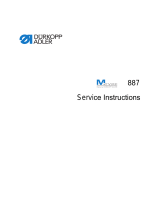Page is loading ...

171 / 173
Service Instrucions

All rights reserved.
Property of Dürkopp Adler AG and protected by copyright. Any reuse of these contents,
including extracts, is prohibited without the prior written approval of Dürkopp Adler AG.
Copyright © Dürkopp Adler AG 2020
IMPORTANT
READ CAREFULLY BEFORE USE
KEEP FOR FUTURE REFERENCE

Table of Contents
Service Instructions 171/173 - 00.0 - 01/2020 1
1 About these instructions ...........................................................3
1.1 For whom are these instructions intended?..................................3
1.2 Representation conventions – symbols and characters...............3
1.3 Other documents..........................................................................4
1.4 Liability..........................................................................................5
2 Safety...........................................................................................7
2.1 Basic safety instructions...............................................................7
2.2 Signal words and symbols used in warnings................................8
3 Working basis...........................................................................11
3.1 Order of the adjustments............................................................11
3.2 Laying the cables........................................................................11
3.3 Gage set and handwheel positions ............................................12
3.3.1 Gage set.....................................................................................12
3.3.2 Handwheel positions ..................................................................13
4 Adjusting the adjusting disk relative to the arm shaft crank ..15
5 Placing the toothed belt at the bottom...................................16
6 Position of needle and hook....................................................17
6.1 Adjusting the rocker bolt for the hook drive and the lower shaft
bearing on the left.......................................................................17
6.2 Adjusting the hook drive housing................................................19
6.3 Adjusting the needle evasive movement (ellipsis width).............20
6.4 Adjusting the symmetry of the hook ...........................................23
6.5 Adjusting the hook in the hook carrier........................................24
6.6 Adjusting looping stroke and needle bar height..........................25
6.7 Adjusting the needle guard.........................................................27
7 Feed dog....................................................................................28
7.1 Adjusting the thrust movement of the feed dog..........................28
7.2 Adjusting the stroke movement of the feed dog .........................30
7.3 Adjusting the retention spring on the hook .................................31
7.4 Adjusting the thread take-up disk...............................................32
8 Adjusting the thread trimmer ..................................................34
9 Adjusting the sewing foot stroke............................................40
9.1 Adjusting the sewing foot stroke for presser feet........................40
9.2 Adjusting the sewing foot stroke for hinged lever feet................43
10 Stitch lengths............................................................................45
10.1 Adjusting normal stitch lengths...................................................45
10.2 Adjusting stitch condensing for the bottom feed.........................46
10.3 Adjusting stitch condensing for the puller...................................47
11 Puller..........................................................................................48
11.1 Adjusting the synchronization of bottom feed and puller............48
11.2 Adjusting the distance between carrier roller and needle...........49
11.3 Adjusting the lift stroke of the carrier roller .................................50
11.4 Adjusting the carrier roller pressure............................................51
11.5 Fabric deflector...........................................................................52

Table of Contents
2 Service Instructions 171/173 - 00.0 - 01/2020
11.6 Toothed belt tension...................................................................52
11.7 Changing the carrier roller..........................................................53
12 Edge pinker...............................................................................54
12.1 Disassembling the edge pinker ..................................................54
12.2 Changing the knives...................................................................55
12.3 Adjusting the cutting pressure....................................................59
12.4 Adjusting point in time for cutting................................................60
12.5 Checking the seam pattern.........................................................62
12.6 Adjusting the chain cutter...........................................................63
13 Programming ............................................................................65
13.1 Adjusting the electropneumatic switching of the carrier roller.....69
13.2 Adjusting the stitch count before the carrier roller is lowered.....69
13.3 Adjusting subclass 550-121 for machines with an edge pinker.....70
14 Maintenance..............................................................................71
14.1 Cleaning .....................................................................................72
14.2 Lubricating..................................................................................73
14.2.1 Checking the lubrication of the machine head............................74
14.2.2 Checking the hook lubrication ....................................................74
14.3 Servicing the pneumatic system.................................................75
14.3.1 Adjusting the operating pressure................................................75
14.3.2 Draining the water-oil mixture.....................................................76
14.3.3 Cleaning the filter element..........................................................77
14.4 Parts list......................................................................................78
15 Decommissioning.....................................................................79
16 Disposal.....................................................................................81
17 Troubleshooting .......................................................................83
17.1 Customer Service.......................................................................83
17.2 Errors in sewing process ............................................................83
18 Technical data...........................................................................85
18.1 Data and characteristic values ...................................................86
18.2 Requirements for fault-free operation.........................................86
19 Appendix ...................................................................................87

About these instructions
Service Instructions 171/173 - 00.0 - 01/2020 3
1 About these instructions
These instructions have been prepared with utmost care. They contain
information and notes intended to ensure long-term and reliable operation.
Should you notice any discrepancies or if you have improvement requests,
then we would be glad to receive your feedback through Customer
Service ( p. 83).
Consider these instructions as part of the product and keep it easily
accessible.
1.1 For whom are these instructions intended?
These instructions are intended for:
• Specialists:
This group has the appropriate technical training for performing
maintenance or repairing malfunctions.
With regard to minimum qualification and other requirements to be met by
personnel, please also follow the chapter Safety ( p. 7).
1.2 Representation conventions – symbols and characters
Various information in these instructions is represented or highlighted
by the following characters in order to facilitate easy and quick
understanding:
Proper setting
Specifies proper setting.
Disturbances
Specifies the disturbances that can occur from an incorrect adjustment.
Cover
Specifies which covers must be disassembled in order to access the
components to be set.
Steps to be performed when operating the machine (sewing and
equipping)
Steps to be performed for service, maintenance, and installation
Steps to be performed via the software control panel
The individual steps are numbered:
First step
Second step
The steps must always be followed in the specified order.
1.
2.
…

About these instructions
4 Service Instructions 171/173 - 00.0 - 01/2020
Lists are marked by bullet points.
Result of performing an operation
Change to the machine or on the display/control panel.
Important
Special attention must be paid to this point when performing a step.
Information
Additional information, e.g. on alternative operating options.
Order
Specifies the work to be performed before or after an adjustment.
References
Reference to another section in these instructions.
Safety Important warnings for the user of the machine are specifically marked.
Since safety is of particular importance, hazard symbols, levels of danger
and their signal words are described separately in the chapter Safety
( p. 7).
Location
information
If no other clear location information is used in a figure, indications of right
or left are always from the user's point of view.
1.3 Other documents
The machine includes components from other manufacturers. Each man-
ufacturer has performed a hazard assessment for these purchased parts
and confirmed their design compliance with applicable European and na-
tional regulations. The proper use of the built-in components is described
in the corresponding manufacturer's instructions.
•

About these instructions
Service Instructions 171/173 - 00.0 - 01/2020 5
1.4 Liability
All information and notes in these instructions have been compiled in
accordance with the latest technology and the applicable standards and
regulations.
Dürkopp Adler cannot be held liable for any damage resulting from:
• Breakage and transport damages
• Failure to observe these instructions
• Improper use
• Unauthorized modifications to the machine
• Use of untrained personnel
• Use of unapproved parts
Transport
Dürkopp Adler cannot be held liable for breakage and transport damages.
Inspect the delivery immediately upon receiving it. Report any damage
to the last transport manager. This also applies if the packaging is not
damaged.
Leave machines, equipment and packaging material in the condition in
which they were found when the damage was discovered. This will ensure
any claims against the transport company.
Report all other complaints to Dürkopp Adler immediately after receiving
the product.

About these instructions
6 Service Instructions 171/173 - 00.0 - 01/2020

Safety
Service Instructions 171/173 - 00.0 - 01/2020 7
2 Safety
This chapter contains basic information for your safety. Read the instruc-
tions carefully before setting up or operating the machine. Make sure to
follow the information included in the safety instructions. Failure to do so
can result in serious injury and property damage.
2.1 Basic safety instructions
The machine may only be used as described in these instructions.
These instructions must be available at the machine's location at all times.
Work on live components and equipment is prohibited. Exceptions are
defined in the DIN VDE 0105.
For the following work, switch off the machine at the main switch or
disconnect the power plug:
• Replacing the needle or other sewing tools
• Leaving the workstation
• Performing maintenance work and repairs
• Threading
Missing or faulty parts could impair safety and damage the machine.
Only use original parts from the manufacturer.
Transport Use a lifting carriage or stacker to transport the machine. Raise the machine
max. 20 mm and secure it to prevent it from slipping off.
Setup The connection cable must have a power plug approved in the relevant
country. The power plug may only be assembled to the connection cable
by qualified specialists.
Obligations
of the operator
Follow the country-specific safety and accident prevention regulations and
the legal regulations concerning industrial safety and the protection of the
environment.
All the warnings and safety signs on the machine must always be in legible
condition. Do not remove!
Missing or damaged warnings and safety signs must be replaced
immediately.
Requirements
to be met by
the personnel
Only qualified specialists may:
• Setting up the machine/putting the machine into operation
• Performing maintenance work and repairs
• Performing work on electrical equipment
Only authorized persons may work on the machine and must first have
understood these instructions.

Safety
8 Service Instructions 171/173 - 00.0 - 01/2020
Operation Check the machine during operating for any externally visible damage.
Stop working if you notice any changes to the machine. Report any chang-
es to your supervisor. Do not use a damaged machine any further.
Safety
equipment
Safety equipment should not be disassembled or deactivated. If it is essen-
tial to disassemble or deactivate safety equipment for a repair operation, it
must be assembled and put back into operation immediately afterward.
2.2 Signal words and symbols used in warnings
Warnings in the text are distinguished by color bars. The color scheme is
based on the severity of the danger. Signal words indicate the severity of
the danger.
Signal words Signal words and the hazard they describe:
Symbols The following symbols indicate the type of danger to personnel:
Signal word Meaning
DANGER (with hazard symbol)
If ignored, fatal or serious injury will result
WARNING (with hazard symbol)
If ignored, fatal or serious injury can result
CAUTION (with hazard symbol)
If ignored, moderate or minor injury can result
CAUTION (with hazard symbol)
If ignored, environmental damage can result
NOTICE (without hazard symbol)
If ignored, property damage can result
Symbol Type of danger
General
Electric shock

Safety
Service Instructions 171/173 - 00.0 - 01/2020 9
Examples Examples of the layout of warnings in the text:
This is what a warning looks like for a hazard that will result in serious
injury or even death if ignored.
This is what a warning looks like for a hazard that could result in
serious or even fatal injury if ignored.
This is what a warning looks like for a hazard that could result in
moderate or minor injury if the warning is ignored.
Puncture
Crushing
Environmental damage
Symbol Type of danger
DANGER
Type and source of danger!
Consequences of non-compliance.
Measures for avoiding the danger.
WARNING
Type and source of danger!
Consequences of non-compliance.
Measures for avoiding the danger.
CAUTION
Type and source of danger!
Consequences of non-compliance.
Measures for avoiding the danger.

Safety
10 Service Instructions 171/173 - 00.0 - 01/2020
This is what a warning looks like for a hazard that could result in envi-
ronmental damage if ignored.
This is what a warning looks like for a hazard that could result in
property damage if ignored.
CAUTION
Type and source of danger!
Consequences of non-compliance.
Measures for avoiding the danger.
NOTICE
Type and source of danger!
Consequences of non-compliance.
Measures for avoiding the danger.

Working basis
Service Instructions 171/173 - 00.0 - 01/2020 11
3 Working basis
3.1 Order of the adjustments
Order
The adjustment positions for the machine are interdependent.
Always comply with the order of individual adjustment steps as specified.
It is absolutely essential that you follow all notices regarding prerequisites
and subsequent settings that are marked with in the margin.
3.2 Laying the cables
Ensure that all cables are laid in the machine such that the function of
moving parts is not hampered.
To lay the cables:
1. Lay any excess cabling neatly in proper cable snakes.
2. Bind together the cable loops with cable ties.
Important
Tie loops wherever possible to fixed parts.
The cables must be secured firmly.
3. Cut off any overlapping cable ties.
NOTICE
Property damage may occur!
Risk of machine damage from incorrect order.
It is essential to follow the working order specified in these
instructions.
NOTICE
Property damage may occur!
Excess cables can impair the functioning of moving machine parts.
This impairs the sewing function and can result in damage.
Lay excess cable as described above.

Working basis
12 Service Instructions 171/173 - 00.0 - 01/2020
3.3 Gage set and handwheel positions
3.3.1 Gage set
Gage Setting
Position of the rocker bolt in the hook drive housing
Position of the hook drive housing
Locking peg
Dial gage for measuring the needle evasive movement
(Ellipsis width) of the hook drive.
Hook slant of 89° 30’
Even hook movement for symmetry

Working basis
Service Instructions 171/173 - 00.0 - 01/2020 13
3.3.2 Handwheel positions
Some settings require that the machine be set to a specific position.
Height of the thread take-up disk
Pusher eccentric for the feed dog
Expansion screw for replacing the arm shaft crank
Position Setting
A Adjusting disk on the upper toothed belt wheel with its deepest slot A
to the groove in the arm shaft crank
B Symmetry of the hook movement
C • Position of the lower toothed belt wheel
• Looping stroke
• Needle bar height
D Stroke and pusher eccentric of the feed dog on right-hand machines
E • Thread pick-up disk
• Eccentric for the puller
F Stroke and pusher eccentric of the feed dog on left-hand machines
Gage Setting

Working basis
14 Service Instructions 171/173 - 00.0 - 01/2020
Fig. 1: Handwheel positions
To lock the machine in place at a specific position:
1. Turn the handwheel to the desired position.
2. Insert the locking peg (1) into the hole (2).
The locking peg (1) is seated in the corresponding slot of the adjusting
disk (3).
The machine has been locked in place.
(1) - Locking peg
(2) - Hole
(3) - Adjusting disk
①② ①② ③
Rotational direction of the machine
B
C
A
F
E
D

Adjusting the adjusting disk relative to the arm shaft crank
Service Instructions 171/173 - 00.0 - 01/2020 15
4 Adjusting the adjusting disk relative to the arm
shaft crank
Fig. 2: Adjusting the adjusting disk relative to the arm shaft crank
Proper setting
The deepest slot A of the adjusting disk is in line with the slot in the arm
shaft crank.
To adjust the adjusting disk relative to the arm shaft crank:
1. Loosen the screws of the set collar.
The set collar is on the left next to the upper toothed belt wheel.
2. Insert the locking peg (2) into the slot (1) of the arm shaft crank.
3. Turn the handwheel until the locking peg (3) can be inserted into
the deepest slot A of the adjusting disk ( p. 13).
4. Move the arm shaft crank to the right until it makes contact with the arm
shaft bearing.
5. Tighten the screws of the set collar.
CAUTION
Risk of injury from moving parts!
Crushing possible.
Switch off the machine before you adjust the
adjusting disk.
(1) - Slot
(2) - Locking peg
(3) - Locking peg
①② ③

Placing the toothed belt at the bottom
16 Service Instructions 171/173 - 00.0 - 01/2020
5 Placing the toothed belt at the bottom
Fig. 3: Placing the toothed belt at the bottom
To place the toothed belt at the bottom:
1. Place the toothed belt.
Make sure both screws in slot C assume the position shown above
and can be accessed with a screw driver ( p. 13).
CAUTION
Risk of injury from moving parts!
Crushing possible.
Switch off the machine before you adjust the
adjusting disk.

Position of needle and hook
Service Instructions 171/173 - 00.0 - 01/2020 17
6 Position of needle and hook
6.1 Adjusting the rocker bolt for the hook drive and the lower
shaft bearing on the left
Fig. 4: Adjusting the rocker bolt for the hook drive and the lower shaft bearing on the left
WARNING
Risk of injury from moving parts!
Crushing possible.
Switch off the machine before you check and adjust
the position of the hook and needle.
NOTICE
Property damage may occur!
There is a risk of machine damage, needle breakage or damage
to the thread if the distance between needle groove and hook tip is
incorrect.
Check and, if necessary, reset the distance to the hook tip after
inserting a needle with a new size.
(1) - Gage
(2) - Rocker bolt
(3) - Face
(4) - Screws
(5) - Screws
(6) - Lower shaft bearing
(7) - Thread trimmer
(8) - Hook carrier
(9) - Screw
(10) - Hook drive housing
(11) - Screw
(12) - Gear wheel
(13) - Eccentric
(14) - Set collar
(15) - Oil collection tray
⑤⑥③
①②③④⑦⑧ ⑨⑩⑪⑫⑬⑭⑮

Position of needle and hook
18 Service Instructions 171/173 - 00.0 - 01/2020
Proper setting
The distance between the middle of needle and the lower shaft bearing on
the left is 39.8 mm.
The distance between the middle of the needle and the end of the rocker
bolt is 38.8 mm.
The rocker bolt must be pushed up against the face of the lower shaft.
To adjust the rocker bolt for the hook drive and the lower shaft bearing on
the left:
1. Tilt the machine head.
2. Loosen the screw (9).
3. Drain the oil.
4. Erect the machine head.
5. Disassemble the following components:
• Needle
• Needle guard
• Hook carrier (8) with hook
• Thread trimmer (7)
6. Loosen the screw (11).
7. Carefully pull off the hook drive housing (10).
While doing so, slowly turn the lower shaft (3).
8. Tighten the gage (1).
9. Loosen the screws (5).
10. Move the lower shaft bearing (6) up to the gage (1).
11. Tighten the screws (5).
12. Loosen the screws (4).
13. Check if the rocker bolt (2) is pushed up against the face (3) of the lower
shaft.
14. Disassemble grease cap and oil collection tray (15).
15. Loosen eccentric (13), set collar (14) and gear wheel (12).
16. Move the lower shaft (3) such that there is a distance of 1 mm between
lower shaft bearing (6) and rocker bolt (2).
The rocker bolt (2) abuts on the gage (1).
17. Push the set collar (14) up against the eccentric (13).
18. Align the gear wheel (12).
19. Tighten the screws.
20. Check the movement of the toothed belt on the lower toothed belt
wheel.
21. If required, align the lower toothed belt wheel.
22. Tighten the screw (9).
23. Assemble the hook drive housing (10).
24. Top off the oil.
/








